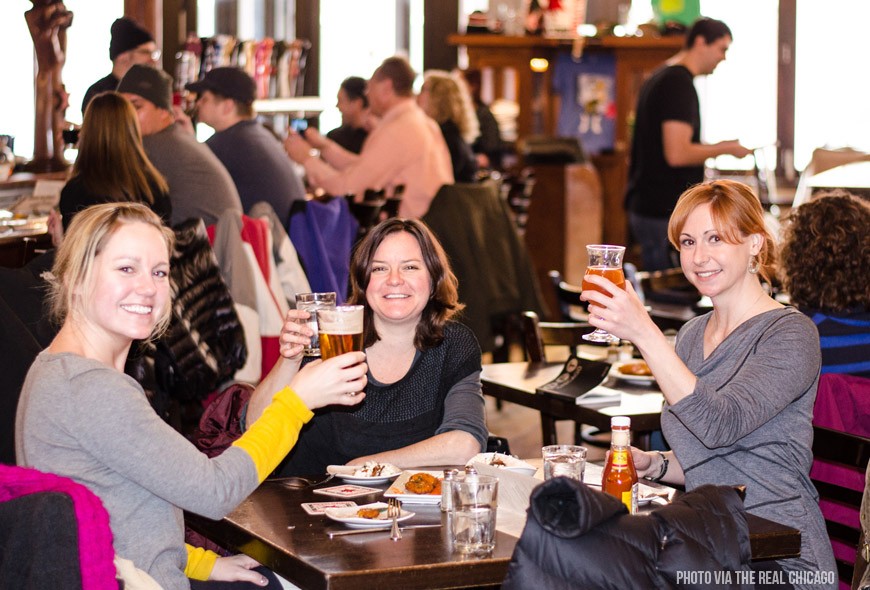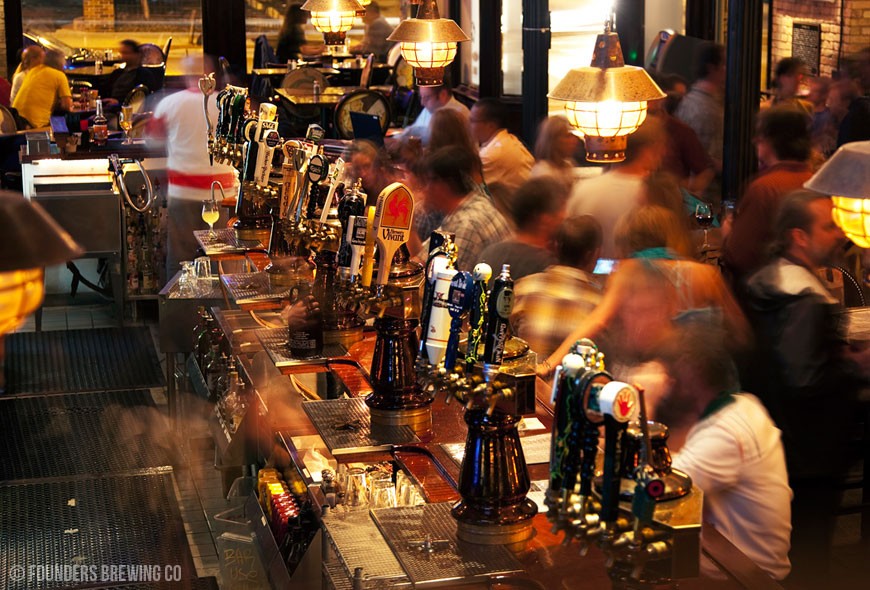Drinking beer alone is fine at times, but wouldn’t you rather go out to a brewery, taste new flavors, find a new favorite, and enjoy a brand new experience? The craft beer industry is exploding and now is the perfect time to discover a local brewery that suits your tastes.
The millennial generation has flocked to the craft beer industry, helping it evolve into something unique and appealing.
Craft vs. Domestic
Over the years the big domestic beer companies have had a stranglehold on the industry, but in the last decade craft breweries have solidified themselves as serious contenders.
While still the smallest market in the U.S. beer industry, craft brewing has grown heavily from 2004 through 2014. Early on, craft beer was only producing about 5.2 million barrels a year. But now that number has nearly tripled, currently sitting at around 15.1 million a year.
The craft beer industry has been holding massive growth numbers while the overall beer market has taken hits. In 2013 the national market had decreased by 1.9 percent while craft beer grew by 17.2 percent.
Anheuser-Busch took in $43.17 billion globally, while craft beer grew to $14.3b in the U.S. alone. Craft beer might not surpass the biggest beer company in the world anytime soon, but the growth is definitely indicative of serious progress, and there is no sign of it slowing down.
Why the Popularity?
Craft beer has taken the U.S. by storm, but why? There haven’t been any significant studies to show the reason behind the industries growth, but here are some possible reasons that come to mind.
Flavor: With domestic beer, consumers usually know what they are going to get. Light beer is always centered on quenching thirst and refreshment as opposed to complex flavors.
Craft beer has always been focused on the total opposite – bold flavors with plenty of depth. Many regional breweries offer food pairings on their menus, showing what flavors can be accented by the food and beer combination.
Founders Brewing Company in Grand Rapids, Michigan writes on its website “We don’t brew beer for the masses. Instead, our beers are crafted for a chosen few, a small cadre of renegades and rebels who enjoy a beer that pushes the limits of what is commonly accepted as taste. In short, we make beer for people like us.”
Creativity: The uniqueness of craft beer finds its roots in the name itself- craft.
There is painstaking effort from craft breweries to create beer that is not only full of flavor, but also totally unique and unprecedented. This effort often gets reflected in the names of the beer as well, like Short’s Brewing Company’s “Huma Lupa Licious,” Big Sky Brewing’s “Moose Drool,” and Stone’s “Arrogant Bastard.”
With beers incorporating things from fruit and chocolate all the way to habanero peppers, these breweries do everything they can to think outside the box.
Experimentation: For many consumers the ability to experiment with new flavors is something that is sought after. Some even take it to the next level by making some craft breweries a travel destination, much like California’s Napa Valley.
The ability to step into a brewpub and see a full-page menu of beer to sample is both nerve-wracking and invigorating. Choosing a random beer off the page turns into a game of discovery, deciding whether a fun name tastes as good as it sounds.
The massive range of flavors combined with exceptionally unique beer names allow patrons to have an entire night dedicated to trying new brews.
The Millennial Influence: The vast majority of current craft beer drinkers are between the ages of 25-34, according to Mintel’s 2013 report. The tasting experience appeals to the generation’s adventurous side, while also being made from healthier natural ingredients. The variety, taste, and experimentation are all reasons for the millennial attraction.
Who Helped Start the Trend?
Between 1994 and 2013, the number of craft breweries in the U.S. went from 537 to 2,786. But which breweries really helped pave the way for the rest?
Founders Brewing Co. – Grand Rapids, MI
Co-owners Dave Engbers and Mike Stevens started Founders Brewing Co. with very little money in their bank accounts, and it took awhile for the brand to get any wind in its sails.
At first, the company tried to make what the rest of the industry was creating; amber ales, wheat beers, and pale ales. But Engbers and Stevens realized that model of business wasn’t working. Founders was a million dollars in debt, and in 2001 the company was facing bankruptcy. Feeling the pressures of impending loss, the partners changed their recipes and began producing beers they wanted to drink themselves.
By not chasing after industry practices, Stevens and Engbers created the “Breakfast Stout”: a beer featuring oatmeal, chocolate, and coffee. The beer helped start a brand new stage of innovation that shook the craft beer industry.
New Belgium Brewing – Fort Collins, CO
Jeff Lebesche took a trip to Belgium, riding through the country on his bicycle, tasting beers. When he got back home to Fort Collins Colorado and created the most popular beer of his future company called “Fat Tire.”
New Belgium started in a basement in 1991 with a husband and wife, and grew into the third largest craft brewery in the U.S. by 2012.
Year round beers at New Belgium include the flagship amber ale “Fat Tire, Ranger IPA, Rampant Imperial IPA, Shift Pale Lager, Sunshine Wheat, and many others.
Dogfish Head Brewery – Rehoboth Beach, DE
Dogfish Head opened the first brewpub in the state of Delaware in 1995 by owner Sam Calagione, and started as the smallest commercial brewery in the country. It was only brewing 12-gallon batches at a time in the beginning, but now is producing 175,000 barrels (43 gallons/barrel) a year.
The company has as many as 39 beers that are created either year round or seasonally, on top of many more which are released on the most rare of occasions.
Dogfish Head was even featured on the Discovery Channel with a series called “Brew Masters,” which helped to massively increase the popularity of craft beer due to the new exposure.
Some of its most popular beers include the famous “60 Minute IPA,” and it’s more expensive counterpart the “120 Minute IPA.”
Who has the Most Breweries?
Across the U.S. there are plenty of craft breweries. Here is a list of states that have the most breweries and the best beer by review.
#1. California – 381 Breweries
The Golden State is currently sitting at the top of the charts for most craft breweries in the country. With places like Stone Brewing Co., Sierra Nevada Brewing Company, and Langunitas Brewing Co., California boasts some of the highest selling companies.
#2. Washington – 201 Breweries
Gordon Biersch Seattle, Chuckanut Brewery, and Fish Brewing all represent the state of Washington and produce some of the top beers in the state. Gordon Biersch Seattle claimed five top-tier beers at the 2014 Washington Beer awards, and brings five high-quality German style beers.
#3. Oregon – 181 Breweries
Oregon has the highest number of breweries per 100,000 adults over 21 (6.3) and brings some very big names to the craft beer industry. Deschutes Brewery placed 6th in the country for sales volumes, and Rogue Ales is one of the most well known Oregon breweries, producing the 2012 gold medal at the Great American Beer Festival with its “Nut Brown Ale.”
#4. Michigan – 131 Breweries
For the past two years running, Grand Rapids, MI has been voted “Beer City USA” via the Beer City USA poll run by Charlie Papazian. Of the 50,000 votes cast throughout the county, 27,005 of which were for Grand Rapids. With influential breweries like Founders, Michigan is well represented.
Where is the Craft Beer Industry Going?
Craft beer is a rising star. The vast amounts of beer options offered now allow people to turn beer drinking into an entirely new experience. With such a massive growth rate in new brewery construction and the millennial generation taking to the experience, the craft brew market has a very bright future.
Read More:
The Spirit of Excellence: Eric Winter and the Rise of Palm Republic Rum
Prost! West Coast Beer Gardens That Are Worth Visiting This Summer
Beer of the Week: Wolaver’s Fine Organic Ales
How David Adelman is Shaking Up the Industry With American Harvest Vodka



